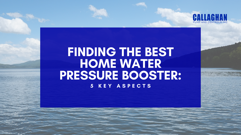Low water pressure can ruin your daily chores like cleaning, washing, and bathing. Luckily, you can install water pressure booster pumps.
Key Principles to Choose the Right Water Booster Pump for House
Identify the Cause of Low Pressure
With increasing improvements in living standards and awareness of water safety, it has become more important than ever to install water purifiers, large showers, and smart toilets. These household devices have certain water pressure requirements to allow for the best customer experience.
In the morning and evening, there are peak hours when multiple people use water at the same time. This may create insufficient water pressure. There are other reasons too, such as gravity, elevation, and fluctuating city main supply. To solve such problems, you will need to install a water pressure booster to the mains inlet pipe.
Understand the Water Source
Make sure what water source you are using. Regular sources are mainly the mains water supply, which may vary significantly with demand. Shallow wells are another common water source. Pumping water from shallow wells will require a booster with priming ability. It has to be able to suck water from underground depths. It is suggested to install a pre-filter to avoid any debris from entering the water pressure booster.
Know the Types of Booster Pumps
Booster pumps are generally centrifugal pumps that pump up the water automatically without any external aid. They can be classified as a kind of self-priming pumps with a noise level slightly lower than other types of pumps, such as jet pumps. This makes booster pumps ideal for long and complex suction applications like transferring water from underground wells or tanks.
Consider Key Parameters
Other key parameters or principles to choose the best water pressure booster are the water delivery volume, the pump head, and the suction head. Represented by the symbol Q, the delivery volume refers to the amount of water that the booster delivers in a unit of time.
The pump head is known as the discharge head of a pump and refers to the maximum height that a booster pump can lift against gravity. It can be recognized as the power of the pump. The greater the power, the more water pressure the pump can generate. It is represented by the symbol H and is measured in meters. Also, consider the suction head, which is the maximum depth from which a pump can raise water via suction.
Summing Up
After figuring out these principles, you will get a basic idea of what water pressure booster pumps are best for your house. For specific model selection, feel free to contact us at Callaghan Pump. We will provide you with the best options that will minimize your water pressure booster pump noise, maintenance, and wear concerns.





